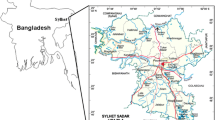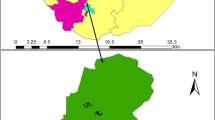Abstract
We tested whether cultivation and fallowing have any significant effect on tree species diversity and dominance in semi-arid Zimbabwe. To this end, we quantified tree species diversity and physiognomy on two soil types (mutapo and bandati) stratified into three land-use categories, i.e., cultivated land, fallow land and woodland. Results showed that tree species diversity was significantly different on the two soil types. Tree species diversity was high on bandati soil and low on mutapo soil. Results also showed that there was significant difference in tree species diversity among the three land-use categories on mutapo soil but no differences on bandati soil. Pairwise comparisons revealed significant differences in species diversity between paired categories on mutapo soil but no significant differences on bandati soil. Tree physiognomy was significantly different among all three land use categories. Colophospermum mopane and Diospyros kirkii were the dominant species within woodlands, while Acacia tortilis subsp. spirocarpa replaced them as the dominant species within the fallow land category. These results indicate that woodland conversion for cultivation purposes has no immediate significant effect on tree species diversity on bandati soil, while it has a pronounced effect on mutapo soil, at least in the short term.




Similar content being viewed by others
References
Asase A, Frimpong KO, Ekpe PK (2010) Impact of cocoa farming on vegetation in an agricultural landscape in Ghana. Afr J Ecol 48:338–346
Augusseau X, Nikiema P, Torquebiau E (2006) Tree biodiversity, land dynamics and famers’ strategies on the agricultural frontier of southwestern Burkina Faso. Biodivers Conserv 15:613–630
Balmford A, Green RE, Scharlemann JPW (2005) Sparing land for nature: exploring the potential impact of changes in agricultural yield on the area needed for crop production. Glob Chan Bio 11:1–12
Baudron F, Corbels M, Monicat F, Giller KE (2009) Cotton expansion and biodiversity loss in African savannahs, opportunities and challenges for conservation agriculture: a review paper based on two case studies. Biodivers Conserv 18:2625–2644. doi:10.1007/s10531-009-9663-x
Baudron F, Corbels M, Andersson JA, Sibanda M, Giller KE (2011) Delineating the drivers of waning wildlife habitat: The predominance of cotton farming on the fringe of protected areas in the Mid-Zambezi Valley, Zimbabwe. Biol Conserv 144:1481–1493. doi:10.1016/j.biocon.2011.01.017
Bierregaard ROJ, Lovejoy TE, Kapos V, Santos AA, Hutchings RW (1992) The biological dynamics of tropical rainforest fragments. BioScience 42:859–866
Biodiversity Project (2002) The Mankind and the animal in the mid-Zambezi valley, Zimbabwe. CIRAD-Emvt. Harare. p 75
Brussaard L, Caron P, Campbell B, Lipper L, Mainka S, Rabbinge R, Babin D, Pulleman M (2010) Reconciling biodiversity conservation and food security: scientific challenges for a new agriculture. Terres Syst 2:34–42
Chizarura L (2003) Impact of globalisation on rural livelihoods; In the mid-Zambezi valley, Harare, SEATINI
Crawley MJ (1997) Plant ecology. Oxford, Blackwell Publishing
Derman B (1996) Changing land-use in the Eastern Zambezi valley: socio-economic considerations. CASS/WWF, Harare
Drummond RB, Coates-Palgrave C (1973) Common trees of the highveld. Salisbury, Longman
Ewers MR, Scharlemann JPW, Balmford A, Green RG (2009) Do increase in agricultural yields spare land for nature? Glob Chan Bio 15:1716–1726
Fischer J, Brosi B, Gretchen CD, Ehrlich PR, Goldman R, Goldstein J, Lindenmayer DB, Manning AD, Mooney HA, Pejchar L, Ranganathan J, Tallis H (2008) Should agricultural policies encourage land sparing or wildlife friendly–farming? Front Ecol Environ 6:380–385
Fritz H, Said S, Renaud PC, Mutake S, Coid C, Monicat F (2003) The effects of agricultural fields and human settlements on the use of rivers by wildlife in the mid-Zambezi valley, Zimbabwe. Lan Ecol 18:293–302
Gardner TA, Barlow J, Chazdon R, Ewers RM, Harvey CA, Peres CA, Sodhi NS (2009) Prospects for tropical forest biodiversity in a human-modified world. Ecol Lett 12:561–582
Green RE, Cornell SJ, Scharlemann JPW, Balmford A (2005) Farming and the fate of wild nature. Science 307:550–555
Guillen KW, Perfect I (2010) Effects of agricultural intensification on the assemblage of leaf-nosed bats (Phyllostomidae) in a coffee landscape in Chiapas, Mexico. Biotropica 42:605–613
Harvey CA, Komar O, Chazdon R, Ferguson BG, Finegun B, Griffith DM, Martinez-Ramos M, Morales H, Nigh R, Soto-Pinto L, Breugel MV, Wishnie M (2008) Integrating agriculture landscapes with biodiversity conservation in the Mesoamerican hotspot. Conserv Biol 22:8–15
International Council for Research into Agroforestry (ICRAF 2001) www site: http://www.ciesin.org/IC/icraf/ICRAF.html
Kadoya T, Washitani I (2011) The Satoyama index: a biodiversity indicator for agricultural landscapes. Agric Ecosyst Environ 140:20–26
Kayhko N, Fagerholm N, Asseid BS, Mzee AJ (2011) Dynamic land use and land cover changes and their effect on forest resources in a coastal village of Matemwe, Zanzibar. Tanzania Land Use Policy 28:26–37
King KFS (1979) Agroforestry and the utilisation of fragile ecosystems. Forest Ecol Manage 2:161–168
Leakey RRB, Tchoundjeu Z, Smith RI, Munro RC, Fondoun JM, Kengue J, Anegbeh PO, Atangana AR, Waruhiu AN, Asaah E, Usoro C, Ukafor V (2004) Evidence that subsistence farmers have domesticated indigenous fruits (Dacryodes edulis and Irvingia gabonensis) in Cameroon and Nigeria. Agro Syst 60:101–111
Magurran AE (1988) Ecological diversity and its measurement. Princeton University Press, Princeton
Maitima JM, Mugatha SM, Reid RS, Gachimbi LN, Majule A, Lyaruu H, Pomery D, Mathai S, Mugisha S (2009) The linkages between land use change, land degradation and biodiversity across East Africa. Afr J Environ Sci Technol 3:310–325
Mapaure I (1994) The distribution of Colophospermum mopane (Leguminosac-Caesalphiniodeae) in Africa. Kirkia 15:1–5
Matson PA, Vitousek PM (2006) Agricultural intensification: will land spared from farming be land spared for nature? Conserv Biol 20:709–710
Mattison EHA, Norris K (2005) Bridging the gaps between agricultural policy, land-use and biodiversity. Tren Ecol Evol 20:610–616
Mvuriye D, Bel SL, Mutak S, Mukutirwa W, Mudavanhu MS, Mapuvire G (2001) Biodiversity in Dande. CIRAD, Harare
Norris K, Asaseb A, Collenc B, Gockowksid J, Masone J, Phalanf B, Wadea A (2010) Biodiversity in a forest-agriculture mosaic–The changing face of West African rainforests. Biol Conserv 143:2341–2350
Oba G, Stenseth NC, Weladji RB (2002) Impacts of shifting agriculture on floodplain woodland regeneration in dryland, Kenya. Agric Ecosyst Environ 90:211–216
Ogunleye AJ, Adeola AO, Ojo LO, Aduradola AM (2004) Impact of farming activities on vegetation in Olokemeji forest reserve, Nigeria. Glob Nest: Int J 6:131–140
Palgrave KC (2002) Trees of Southern Africa. Struik Publishers, Cape Town
Poilecot P, Gaidet N (2011) A quantitative study of the grass and woody layers of a Mopane (Colophospermum mopane) savannah in the mid-Zambezi Valley, Zimbabwe. Afr J Ecol 49:150–164
Rudel TK, Schneider L, Uriarte M, BL Turner ΙΙ, DeFries R, Lawrence D, Geoghegan J, Hecht S, Ickwizt A, Lambin EF, Birkenholtz T, Batista S, Grau R (2009) Agricultural intensification and changes in cultivated areas. PNAS 106:20675–20680
Scherr SJ, McNeely JA (2008) Biodiversity conservation and agricultural sustainability: towards a new paradigm of ‘ecoagriculture’ landscapes. Phil Trans R Soc B 363:477–494
Tabor K, Burgess ND, Mbilinyi BP, Kashaigili JJ, Steininger MK (2010) Forest and woodland cover and change in coastal Tanzania and Kenya, 1990 to 2000. J East Afr Nat His 99:19–45
Teodoro AV, Munoz A, Tscharntke T, Klein AM, Tylianakis JM (2011) Early succession arthropod community changes on experimental passion fruit plant patches along a land-use gradient in Ecuador. Agric Ecosyst Environ 140:14–19
Tilman D, Fargione J, Wolf B, Antonio CD, Dobson A, Howarth R, Schindler D, Schlesinger WH, Simberloff D, Swackhamer D (2001) Forecasting agriculturally driven global environmental change. Science 292:281–284
Timberlake JR, Drummond RB, Maroyi A (1988) Biodiversity assessment of the lower Guruve region. Zambezi Valley, Zimbabwe. Occasional Publications on Biodiversity 4
Timberlake JR, Nobanda N, Mapaure I (1993) Vegetation survey of the communal lands-North and West of Zimbabwe. Kirkia 14:171–204
Tripathi OP, Upadhaya K, Tripathi RS, Pandey HN (2009) Diversity, dominance and population structure of trees species along fragment-size gradient of a subtropical humid forest of northeast India. Res J Environ Earth Sci 2:97–105
Van Wyk BV, Van Wyk PV (1997) Field guide to trees of Southern Africa, Struik Publishers. Cape Town
Acknowledgements
This study would not have been possible without efforts from colleagues from the Department of Biological Sciences, Tropical Resource Ecology Program, and the Department of Geography and Environmental Science University of Zimbabwe. We thank the Ministère Français des Affaires Etrangères et Européennes for supporting (Edwin Tambara) through the French Embassy in Zimbabwe (Research Platform-Production and Conservation in Partnership, RP-PCP grant/CC#4). Mbire Rural District Council allowed the work to be carried out in the area.
Author information
Authors and Affiliations
Corresponding author
Rights and permissions
About this article
Cite this article
Tambara, E., Murwira, A., Kativu, S. et al. Farming does not necessarily conflict with tree diversity in the mid-Zambezi valley, Zimbabwe. Agroforest Syst 84, 299–309 (2012). https://doi.org/10.1007/s10457-011-9467-3
Received:
Accepted:
Published:
Issue Date:
DOI: https://doi.org/10.1007/s10457-011-9467-3




